-

-

-

-

-

-

-

-

-

-

-

The hipped roof is a distinguishing feature of the bungalow style which is particularly appropriate for hot climates, since warm air rises up into the high roof and leaves the rooms below cooler.
-

After 13 years of wrestling with a problem kitchen, a late night Eureka led to an entire transformation. The old pine glass-front cupboards had originally flanked the dining entry to the kitchen. The cabinets blocked views and forced foot traffic right through the work area. The couple wanted to keep these antique built-ins (which Ron had refinished), but needed more counter space. Suddenly Dolly realized those two cabinets could shift over to the only solid dining area wall, be pushed together, and solve several problems. The rest was easy.
-

The jalousie windows turned into shallow shelves are an ideal place for the family's endless small collectables, early to mid-20th century toys, tins, hand puppets, and ethnic dolls.
-

The restaurant is open on weekend evenings for dinner and available for special events.
-

The restaurant is two blocks from the courthouse.
-

There are two front rooms which serve as dining areas.
-

The dining rooms are accessed from a central hall.
-
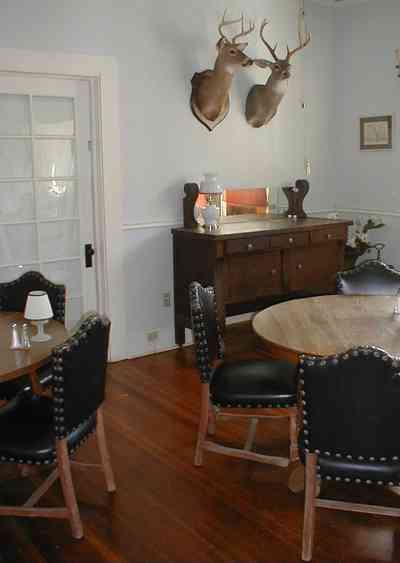
This dining room is on the south side of the central hall.
-

The dining room is furnished like a hunting lodge.
-

The house exemplifies the bungalow style. It harmonizes with its surroundings because of its low broad proportions and lack of ornamentation giving it a character so natural that it seems to blend into the landscape.
-

The roof with its wide overhang displays exposed rafters typical of the craftsman style.
-

As in this example, bungalows display a fine degree of craftsmanship and are constructed of materials left as closed as possible to their natural state.
-

Sears and Roebuck spread the bungalow style across the country by offering several models in its mail-order catalogs.
-

The exterior color scheme was based on reserch on the Gamble House in Pasadena designed by the Greene brothers.
-

-

-

-

-

-
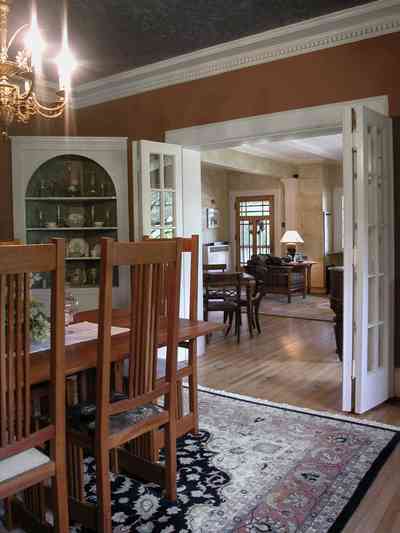
The design of the major rooms is forthright and functional. The living room is directly connected to the dining room.
-

-

-

-

-

Rough and irregular brickwork is distinctive of the craftsman style. Clinker-bricks were originally discarded because they were discolored or distorted. Around 1920, they were discovered by Craftsman architects to be usable, distinctive and charming! The name "clinker-brick" comes from the sound that they would make when banged together, being heavier than regular bricks.
Click here to see other examples of clinker bricks. -

The bungalow stretched to the out-of-doors. Glass doors lead to the swimming pool area.
-

-

The guest house includes a bedroom, bath and studio.
-
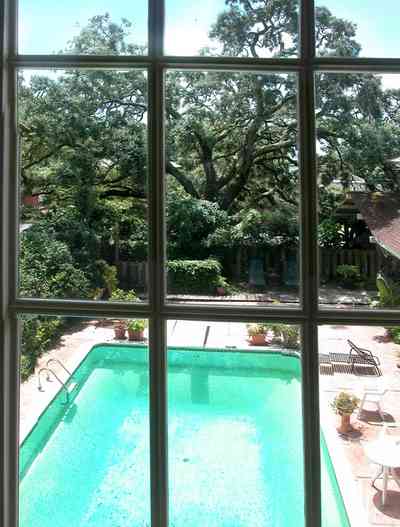
Five casement windows face the heritage oak tree is reminiscent of the grouping of ten windows front the main house
-

The second floor of the guest quarters includes a studio office space.
-

Beaded wood panels were installed beneath windows and in the stairwell whose railing desing duplicated that of the main house.
-

-

Original materials were procurred to match the new building including cedar shakes from Canada and cypress beams from Louisiana.
-

The screen porch was detailed to match the front porch of the main house and brackets were placed to support the exposed rafter tails as on the main house.
-

-

-

Some of the streets in the Old East Hill neighborhood have an uncovered brick base.
-

-

-

-

-

-

The house harmonizes with its surroundings because of low broad proportions and lack of ornamentation.
-

The facade of the home faces west. There is an overstory of large water oaks. An adjoining garage apartment can be seen at the end of the driveway with the barn immediately to the rear.
-

The style of architecture is often referred to as Craftsman. These dwellings display a fine degree of craftsmanship and are constructed of materials left as close as possible to their natural state.
-
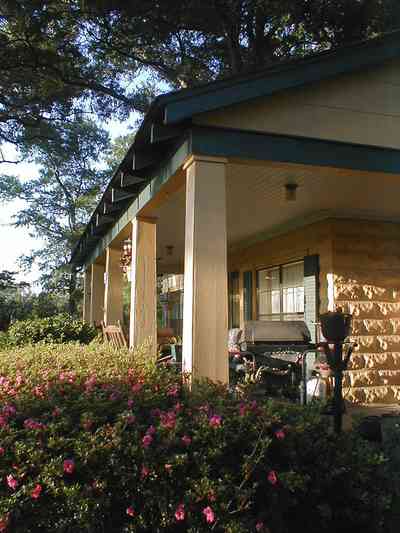
The walls are laid in quarried stone.
-

The lean-to on the side of the barn is used as a chicken coop.
-
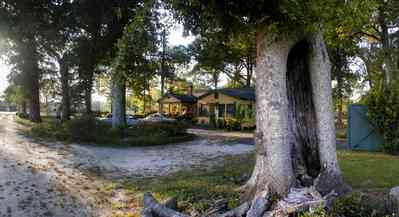
The driveway off Highway 97 is on the left of the photograph.











 The hipped roof is a distinguishing feature of the bungalow style which is particularly appropriate for hot climates, since warm air rises up into the high roof and leaves the rooms below cooler.
The hipped roof is a distinguishing feature of the bungalow style which is particularly appropriate for hot climates, since warm air rises up into the high roof and leaves the rooms below cooler. After 13 years of wrestling with a problem kitchen, a late night Eureka led to an entire transformation. The old pine glass-front cupboards had originally flanked the dining entry to the kitchen. The cabinets blocked views and forced foot traffic right through the work area. The couple wanted to keep these antique built-ins (which Ron had refinished), but needed more counter space. Suddenly Dolly realized those two cabinets could shift over to the only solid dining area wall, be pushed together, and solve several problems. The rest was easy.
After 13 years of wrestling with a problem kitchen, a late night Eureka led to an entire transformation. The old pine glass-front cupboards had originally flanked the dining entry to the kitchen. The cabinets blocked views and forced foot traffic right through the work area. The couple wanted to keep these antique built-ins (which Ron had refinished), but needed more counter space. Suddenly Dolly realized those two cabinets could shift over to the only solid dining area wall, be pushed together, and solve several problems. The rest was easy. The jalousie windows turned into shallow shelves are an ideal place for the family's endless small collectables, early to mid-20th century toys, tins, hand puppets, and ethnic dolls.
The jalousie windows turned into shallow shelves are an ideal place for the family's endless small collectables, early to mid-20th century toys, tins, hand puppets, and ethnic dolls. The restaurant is open on weekend evenings for dinner and available for special events.
The restaurant is open on weekend evenings for dinner and available for special events. The restaurant is two blocks from the courthouse.
The restaurant is two blocks from the courthouse. There are two front rooms which serve as dining areas.
There are two front rooms which serve as dining areas. The dining rooms are accessed from a central hall.
The dining rooms are accessed from a central hall. This dining room is on the south side of the central hall.
This dining room is on the south side of the central hall. The dining room is furnished like a hunting lodge.
The dining room is furnished like a hunting lodge. The house exemplifies the bungalow style. It harmonizes with its surroundings because of its low broad proportions and lack of ornamentation giving it a character so natural that it seems to blend into the landscape.
The house exemplifies the bungalow style. It harmonizes with its surroundings because of its low broad proportions and lack of ornamentation giving it a character so natural that it seems to blend into the landscape. The roof with its wide overhang displays exposed rafters typical of the craftsman style.
The roof with its wide overhang displays exposed rafters typical of the craftsman style. As in this example, bungalows display a fine degree of craftsmanship and are constructed of materials left as closed as possible to their natural state.
As in this example, bungalows display a fine degree of craftsmanship and are constructed of materials left as closed as possible to their natural state. Sears and Roebuck spread the bungalow style across the country by offering several models in its mail-order catalogs.
Sears and Roebuck spread the bungalow style across the country by offering several models in its mail-order catalogs. The exterior color scheme was based on reserch on the Gamble House in Pasadena designed by the Greene brothers.
The exterior color scheme was based on reserch on the Gamble House in Pasadena designed by the Greene brothers.




 The design of the major rooms is forthright and functional. The living room is directly connected to the dining room.
The design of the major rooms is forthright and functional. The living room is directly connected to the dining room.



 Rough and irregular brickwork is distinctive of the craftsman style. Clinker-bricks were originally discarded because they were discolored or distorted. Around 1920, they were discovered by Craftsman architects to be usable, distinctive and charming! The name "clinker-brick" comes from the sound that they would make when banged together, being heavier than regular bricks. Click here to see other examples of clinker bricks.
Rough and irregular brickwork is distinctive of the craftsman style. Clinker-bricks were originally discarded because they were discolored or distorted. Around 1920, they were discovered by Craftsman architects to be usable, distinctive and charming! The name "clinker-brick" comes from the sound that they would make when banged together, being heavier than regular bricks. Click here to see other examples of clinker bricks. The bungalow stretched to the out-of-doors. Glass doors lead to the swimming pool area.
The bungalow stretched to the out-of-doors. Glass doors lead to the swimming pool area.
 The guest house includes a bedroom, bath and studio.
The guest house includes a bedroom, bath and studio. Five casement windows face the heritage oak tree is reminiscent of the grouping of ten windows front the main house
Five casement windows face the heritage oak tree is reminiscent of the grouping of ten windows front the main house The second floor of the guest quarters includes a studio office space.
The second floor of the guest quarters includes a studio office space. Beaded wood panels were installed beneath windows and in the stairwell whose railing desing duplicated that of the main house.
Beaded wood panels were installed beneath windows and in the stairwell whose railing desing duplicated that of the main house.
 Original materials were procurred to match the new building including cedar shakes from Canada and cypress beams from Louisiana.
Original materials were procurred to match the new building including cedar shakes from Canada and cypress beams from Louisiana. The screen porch was detailed to match the front porch of the main house and brackets were placed to support the exposed rafter tails as on the main house.
The screen porch was detailed to match the front porch of the main house and brackets were placed to support the exposed rafter tails as on the main house.

 Some of the streets in the Old East Hill neighborhood have an uncovered brick base.
Some of the streets in the Old East Hill neighborhood have an uncovered brick base.




 The house harmonizes with its surroundings because of low broad proportions and lack of ornamentation.
The house harmonizes with its surroundings because of low broad proportions and lack of ornamentation. The facade of the home faces west. There is an overstory of large water oaks. An adjoining garage apartment can be seen at the end of the driveway with the barn immediately to the rear.
The facade of the home faces west. There is an overstory of large water oaks. An adjoining garage apartment can be seen at the end of the driveway with the barn immediately to the rear. The style of architecture is often referred to as Craftsman. These dwellings display a fine degree of craftsmanship and are constructed of materials left as close as possible to their natural state.
The style of architecture is often referred to as Craftsman. These dwellings display a fine degree of craftsmanship and are constructed of materials left as close as possible to their natural state. The walls are laid in quarried stone.
The walls are laid in quarried stone. The lean-to on the side of the barn is used as a chicken coop.
The lean-to on the side of the barn is used as a chicken coop. The driveway off Highway 97 is on the left of the photograph.
The driveway off Highway 97 is on the left of the photograph. One Tank of Gas
One Tank of Gas